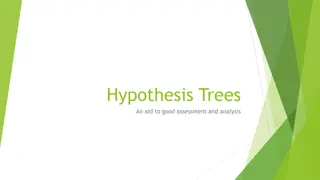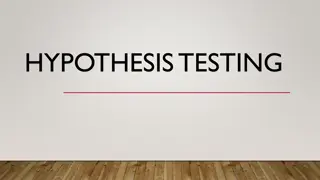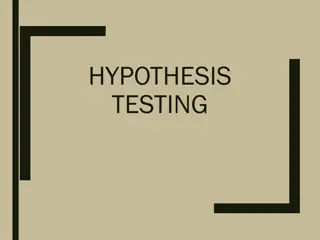Understanding Research Aims, Objectives, and Hypothesis in Health Research
This content delves into the importance of defining research aims, objectives, and hypotheses in health research. It explains how research aims clarify the study's goals, objectives outline specific tasks to achieve those goals, and hypotheses help in making predictions. It also discusses the process of turning a research question into a hypothesis, emphasizing the necessity of refining variables and operational definitions. The readings list provides additional resources for further understanding research methods in health.
Download Presentation

Please find below an Image/Link to download the presentation.
The content on the website is provided AS IS for your information and personal use only. It may not be sold, licensed, or shared on other websites without obtaining consent from the author. Download presentation by click this link. If you encounter any issues during the download, it is possible that the publisher has removed the file from their server.
E N D
Presentation Transcript
DAY 2: AIMS/ OBJECTIVES/ HYPOTHESIS Sioape Kupu Health Research Officer
DAY 2 OBJECTIVES Understand what an aim is? 1) Understand what an objective is? 2) Understand what a Hypothesis? 3)
READINGS LIST Bowling, A. (2002). Research methods in health : investigating health and health services. Philadelphia, PA, Open University Press.* Punch, K. (2005). Introduction to social research : quantitative and qualitative approaches. London, SAGE.* Saks, M. and J. Allsop (2007). Researching health : qualitative, quantitative and mixed methods. Los Angeles, SAGE Publications.*
RESEARCH AIMS Comes from the research question Clarify exactly what the research is trying to achieve Research aim(s): Broad statements of desired outcomes, or the general intentions and purpose of the research Emphasize what is to be accomplished, not how it is to be accomplished Reflect the aspirations and expectations of the research topic Often involves simply turning the research question into a statement of intent E.g. the aim of this study is to identify how peer pressure affects young males (17-25yrs) attendance at sexual health services.
RESEARCH OBJECTIVES The operational task(s) that need to be accomplished to meet the aim(s) and answer the question Emphasize how aims are to be accomplished Must be highly focused and feasible Address the more immediate project outcomes Precise definition of all concepts relevant to the research E.g. the research seeks to determine: 1. The association between peer pressure and attendance. 2. The association between peer group size, peer pressure and attendance. 3. The association between ethnicity, peer pressure and attendance. 4. The association between age, peer pressure and attendance.
RESEARCH HYPOTHESIS Steps in Turning Your Research Question into a Hypothesis 1) Start with a research question 2) Specify how the variables in your question are related to each other 3) Refine your hypothesis 4) Decide on your research design 5) Develop operational definitions 6) Make predictions to test
RESEARCH HYPOTHESIS Step 1: Develop a Research Question e.g. How does peer pressure influence young males (17-25 yrs) attendance at sexual health services?
RESEARCH HYPOTHESIS Step 2a: Identify an Association to Test Factor 1 is related to Factor 2 Definition of Factor: Any type of attribute, behavior or state of a biological, psychological or social environment e.g. Young males who attend a sexual health service will have different exposure to peer pressure than those who do not attend. Factor 1 = peer pressure Factor 2 = attendance
RESEARCH HYPOTHESIS Step 2b: Specify the Direction Specify the direction of the relationship (if appropriate) e.g. Negative peer pressure decrease in likelihood of attendance Should specify: Change in one factor (variable) leads to a change in another factor (variable) Independent Variable (IV) the variable that causes the DV to change The hypothesis always specifies that the IV causes changes in the DV Dependent Variable (DV) - the variable that changes as a result of the IV changing. The hypothesis always specifies that the DV changes in reaction to changes in the IV NOTE: Some hypotheses do not specify a causal relationship and will therefore only have DVs only looking for relationships e.g. Young males (17-25 yrs) who attend a sexual health service will have less exposure to negative peer pressure than those who do not attend. This is your initial hypothesis
RESEARCH HYPOTHESIS Step 3: Refine Narrow focus of your hypotheses based on your literature review and/or research question What? Who? When? Where? Example: Young Northland males (17-25 yrs) who attend a sexual health clinic (Family Planning or hospital-based sexual health clinic) or GP for chlamydia screening (urine sample screening test) will have significantly less exposure to negative peer pressure than those who are not screened for chlamydia.
RESEARCH HYPOTHESIS Step 4: Decide on the research design The research design will determine exactly what you can test and therefore how you write your hypothesis Examples: Observational cross-sectional design: Observe naturally occurring variation in the independent variable and measure the dependent variable at one time point Young Northland males (17-25 yrs) who have attended a sexual health clinic (Family Planning or hospital-based sexual health clinic) or GP for chlamydia screening (urine sample screening test) will recall significantly less exposure to negative peer pressure than those who are not screened for chlamydia. Observational longitudinal design: Observe naturally occurring variation in the independent variable and measure the dependent variable over a period of time Young Northland males (17-25 yrs) who report significantly less exposure to negative peer pressure over a 6 month period will be significantly more likely to be screened for chlamydia (urine sample screening test) by attending a sexual health clinic (Family Planning or hospital- based sexual health clinic) or GP in the subsequent 6 month period.
RESEARCH HYPOTHESIS Step 5: Operationalize Definitions (if required). Turning theoretical constructs into controllable and/or measurable variables Example: Young Northland males (17-25 yrs) who have attended a sexual health clinic (Family Planning or hospital-based sexual health clinic) or GP for chlamydia screening (urine sample screening test) will recall (in the past 6 months) significantly less exposure to negative peer pressure (self-reported negative comments relating to sexual health checks) than those who are not screened for chlamydia.
RESEARCH HYPOTHESIS Step 6: Null & Alternate Hypotheses Null Hypothesis [H0]: Proposes no relationship between independent and dependent variables This is what we are testing with our data. (Alternate) Hypothesis [H1]: Proposes there is a relationship between the independent and dependent variables This is what our result provides some evidence for if we have enough evidence to reject the Null Examples: Null Hypothesis: Young Northland males (17-25 yrs) who have attended a sexual health clinic (Family Planning or hospital-based sexual health clinic) or GP for chlamydia screening (urine sample screening test) will recall (in the past 6 months) no more or less exposure to negative peer pressure (self-reported negative comments relating to sexual health checks) than those who are not screened for chlamydia. (Alternate) Hypothesis: Young Northland males (17-25 yrs) who have attended a sexual health clinic (Family Planning or hospital-based sexual health clinic) or GP for chlamydia screening (urine sample screening test) will recall (in the past 6 months) significantly less exposure to negative peer pressure (self-reported negative comments relating to sexual health checks) than those who are not screened for chlamydia. When we test this we will almost always test for a difference in either direction, so we usually specify non-directional alternate hypotheses.
ACTIVITY 1) Create an Aim 2) Create Objectives 3) Create a Hypothesis Steps for creating a Hypothesis 1) Start with the research question 2) Specify how the variables in your question are related to each other 3) Refine your hypothesis 4) Decide on your research design 5) Develop operational definitions 6) Make predictions to test (Null & Alternative Hypothesis)
DAY 2.1 OBJECTIVES Understand what an aim is? 1) Understand what an objective is? 2) Understand what a Hypothesis? 3)
READING Bouma, G., D. and R. Ling (2004). Chapter 6: Selecting a research design. The research process. Melbourne ; New York, Oxford University Press: 86-111. MALO























